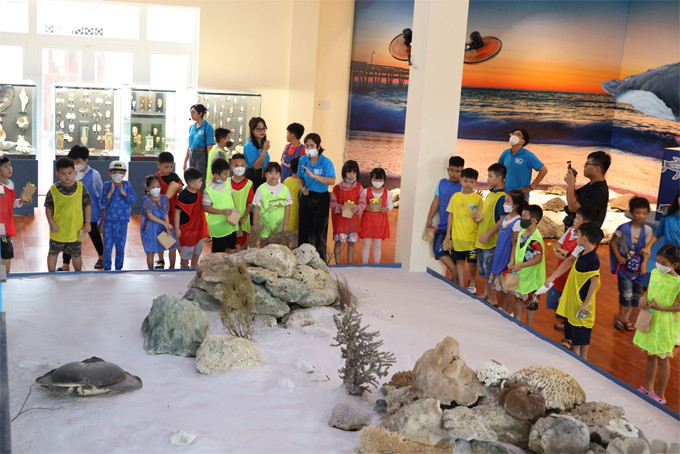
Founded on September 14th, 1922, the Museum of Oceanography formerly known as Indochina Fisheries Oceanographic Service is a popular destination for both domestic and foreign tourists to explore marine life, contributing to inspiring the love for the sea and islands....
Founded on September 14th, 1922, the Museum of Oceanography formerly known as Indochina Fisheries Oceanographic Service is a popular destination for both domestic and foreign tourists to explore marine life, contributing to inspiring the love for the sea and islands
A 400m2 museum with 4,000m of shelves of 7, 000 bottles of samples of marine species was built in 1948. In 1958, the collection increased to include 42,000 samples. The management of the samples has been boosted to facilitate the search and reference.

|
“In addition to the purpose of serving research, the museum is also in charge of exchanging samples with other museums in the world such as: the French National Museum of Natural History, the Natural History Museum of London (UK)… The samples of about 200 marine species of the Museum of Oceanography have been transferred to various museums around the world”, said Associate Professor - PhD. Dao Viet Ha.
Reportedly, PhD. Armand Kempf (First Director of the Institute of Oceanography) proposed building an aquarium system to serve scientific research as well as welcome visitors. In 1937, the Indochina Institute of Oceanography opened to visitors to the Aquarium Museum. The Marine museum had 24 submersible tanks and 6 large tanks after two renovations, in 1943. The marine fauna and corals in the aquariums became the top tourist destination in Nha Trang with nearly 50,000 visitors per year by 1958.
Experiencing historical upheavals, many specimens have been damaged or lost. The Specimen Museum and the Marine Museum were merged into Oceanographic Museum. “Currently, the museum has more than 27,000 marine specimens of nearly 6,000 species collected in Vietnam and surrounding areas,” said PhD. Truong Hai Trinh, Chief of Environmental Education and Communication Department, Museum of Oceanography.
In recent years, the Museum of Oceanography has developed in terms of infrastructures and service quality. Apart from the aquarium for marine life and the specimen exhibition together with an 18m-long humpback whale skeleton, weighing 10 tons, discovered in Nam Dinh in 1994; sea cow skeleton weighing nearly 300kg from Con Dao, the museum has invested in many new valuable exhibits.
The most impressive is a marine resource exhibition of Spratly and Paracel Islands marine biodiversity innovated from a 128m mountain tunnel built by the French in the 1930s. It comprises of 6 large tanks themed “Ocean Vigor” with a capacity of up to 165m3 featuring the lure of the ocean world with unique ecosystem of Vietnam’s sea, islands and the Spratly and Paracel Islands. The aquarium showcases vast range of marine species such as Balistes, Chaetodontidae, Diagramma pictum, Labridae, etc. Noticeably, there is a 25m tunnel where large and potentially dangerous organisms such as sharks and rays can be seen.
The Institute of Oceanography has just put the "Marine Biodiversity" exhibition area into operation showcasing tens of thousands of specimens of organisms, minerals and information about Vietnam's marine biodiversity. In particular, the No. 100 collection of stylized transparent marine life specimens to celebrate the 100th anniversary of the establishment of the institute and a collection of 3 types of beautiful seaweed specimens in Vietnam.
Reopening after Covid-19, the Museum of Oceanography welcomed more than 500,000 visitors, including students in 2022. Nguyen Quoc Duy, a student from Da Lat City, Lam Dong Province said, “the visit to the Museum of Oceanography helps me learn more about marine resources in Vietnam, especially the responsibility to protect the national sovereignty over the Spratly and Paracel Islands.
The Museum of Oceanography has become a destination for marine education, contributing to raising public awareness of the biodiversity of Vietnam's sea and islands and marine environmental protection.
X.T
Translated by N.T




